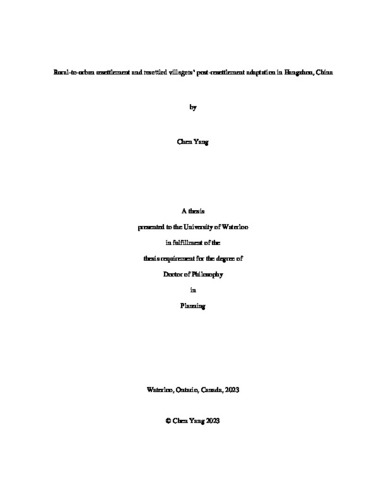| dc.description.abstract | In recent years, rural-to-urban resettlement as a specific form of urbanization and its long-lasting impact on landless villagers have garnered increasing scholarly and policy attention in China. Urbanization through resettlement has thus become a potent tool for the Chinese government to embrace the new-type urbanization, which highlights the integrated urban-rural development and the citizenization of the rural population in urban areas. During this process, resettled villagers were physically relocated into concentrated resettlement communities and underwent an arduous adaptation process to the host city. This dissertation adopts an integrated conceptual framework to analyze decade-long resettlement practices in Hangzhou, China. Through an explanatory sequential mixed methods approach design, this dissertation sheds light on how urbanization through resettlement unfolds and how resettled villagers adapt to urban society. More specifically, it explores the following questions. What are the spatial characteristics of resettlement communities regarding material deprivation? How is space socially produced in resettlement communities? How has China’s property rights system influenced resettlement practices and resettled villagers’ post-resettlement adaptation?
This dissertation follows the article-based format, and the three articles together offer a step-wise approach to untangling the complexities of rural-to-urban resettlement in China. The first article investigates what dimension of resettlement communities by focusing on their spatial characteristics. It invokes the concept of deprivation and aims to establish indices of multiple deprivations (IMDs) for resettlement communities. In doing so, the article uses accessibility as a proxy and integrates the space syntax approach with multi-criteria decision analysis to construct the IMDs of concentrated resettlement communities in Hangzhou, China. The utilized data consists of street networks obtained from OpenStreetMap, Point of Interest (POI) gathered through Amap API, and interviews conducted within the local communities. The findings suggest that material deprivation may not be the primary rationale for residential segregation of resettlement communities in urban areas. In addition, the accessibility to different services reflects diverse material deprivation patterns of resettlement communities. Moreover, the perceived deprivation of various stakeholders, such as resettled villagers, planners, and local government officials, may lead to different results of the IMDs. The diverse criteria or domains of deprivation contribute differently to the deprivation, which requires a tailored treatment strategy when constructing IMDs, such as the sensitivity analysis used in this research. It is recommended to incorporate perceived deprivation measurement as the essential component of pre-resettlement assessment.
The second article further explores how space is produced in resettlement communities. The production of concentrated resettlement communities (CRCs) to accommodate resettled villagers and facilitate their post-resettlement adaptation creates a unique urban phenomenon in China. However, existing research has insufficiently unpacked the evolution of the production process. Building on the theory of space production, this article proposes a dynamic spatial-temporal conceptual framework to examine the process of space production. Drawing on interviews with residents, local planners, policy makers, and academics, as well as large sample questionnaire surveys, the article offers an empirical lens on how CRCs have evolved and how landless farmers have adapted to the host city. It first finds that CRCs in Hangzhou have three typologies in terms of spatial layout and built form. Secondly, resettled villagers in early CRCs are confronted with economic challenges but maintain well social relations. Their shared collectivism is conducive to their spatial adaptation. In recent CRCs, strict planning and community management have further limited resettled villagers' spontaneous attempts to reshape space to support their adaptation.
The third article delves into why it is challenging to achieve inclusive rural-to-urban resettlement by focusing on the property rights regime in China. While the Chinese government intends to use resettlement to address the ambiguous property rights in rural areas, resettlement projects may deviate from the presupposed ideal path of achieving equitable property rights through property rights rearrangements. This article aims to unpack the complexity of property rights embedded in rural-to-urban resettlement based on the empirical case of Hangzhou. Based on documentary analysis, field observation, in-depth interviews, and questionnaire surveys, the article argues that the ambiguous property rights system of rural land cannot be fully addressed through rural-to-urban transition, and the coexistence of private, collective, formal and informal property rights systems is inevitable in urban areas without targeted policy remedies. The findings identify some main obstacles to the ideal transition of property rights systems. First, the resettled villagers are excluded from market participation by inadequate compensation through planning mechanisms. Second, resettlement communities suffer from the remaining rurality that challenges the enforcement of formal institutions and the governance of communal resources in the urban system. Third, the collective-retained land is an innovative but compromised institution devised by the local government to achieve a fair property rights rearrangement through resettlement, but its effectiveness is weakened by the politics at the village level.
In summary, this dissertation provides a detailed reading of rural-to-urban resettlement practices and a nuanced understanding of resettled villagers’ post-resettlement adaptation in contemporary China. More importantly, the findings can have important policy implications for sustainable urban-rural development in China regarding offering better locational choices for resettlement communities, accommodating the spatial demands of resettled villagers, and achieving equitable property rights for the affected. | en |

